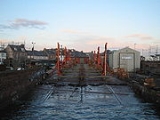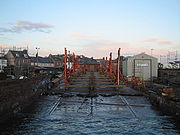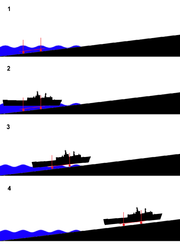
Patent slip
Encyclopedia


Scot
A Scot is a member of an ethnic group indigenous to Scotland, derived from the Latin name of Irish raiders, the Scoti.Scot may also refer to:People with the given name Scot:* Scot Brantley , American football linebacker...
Thomas Morton
Thomas Morton (shipwright)
Thomas Morton was a Scottish shipwright and inventor. His most widely known invention is the patent slip.-Biography:Morton was born in Leith in October 1781 and grew up to become a shipwright like his father, Hugh...
in 1818 as a cheaper alternative to a dry dock
Dry dock
A drydock is a narrow basin or vessel that can be flooded to allow a load to be floated in, then drained to allow that load to come to rest on a dry platform...
for ship
Ship
Since the end of the age of sail a ship has been any large buoyant marine vessel. Ships are generally distinguished from boats based on size and cargo or passenger capacity. Ships are used on lakes, seas, and rivers for a variety of activities, such as the transport of people or goods, fishing,...
repair. It consisted of an inclined plane
Inclined plane
The inclined plane is one of the original six simple machines; as the name suggests, it is a flat surface whose endpoints are at different heights. By moving an object up an inclined plane rather than completely vertical, the amount of force required is reduced, at the expense of increasing the...
, which extended well into the water, and a wooden cradle onto which a ship was floated. The ship was then attached to the cradle and hauled out of the water up the slip.
In 1832, a House of Commons
British House of Commons
The House of Commons is the lower house of the Parliament of the United Kingdom, which also comprises the Sovereign and the House of Lords . Both Commons and Lords meet in the Palace of Westminster. The Commons is a democratically elected body, consisting of 650 members , who are known as Members...
Select Committee, under the chairmanship of the, Rt. Hon. Sir George Cockburn
George Cockburn
Admiral of the Fleet Sir George Cockburn, 10th Baronet GCB was a British naval commander of the late 18th through the mid-19th centuries. He held important commands during the Napoleonic Wars and the War of 1812 and eventually rose to become Admiral of the Fleet and First Sea Lord.-Naval...
, was convened to adjudicate on a petition
Petition
A petition is a request to do something, most commonly addressed to a government official or public entity. Petitions to a deity are a form of prayer....
by Thomas Morton to extend the duration of his patent
Patent
A patent is a form of intellectual property. It consists of a set of exclusive rights granted by a sovereign state to an inventor or their assignee for a limited period of time in exchange for the public disclosure of an invention....
. The committee eventually did not support the patent extension. It was claimed that not only was the cost of a slip one tenth of a dry dock but also by hauling completely onto a clear dry area that it was easier to carry out the maintenance.
Early designs would have used manpower and block and tackle
Block and tackle
A block and tackle is a system of two or more pulleys with a rope or cable threaded between them, usually used to lift or pull heavy loads.The pulleys are assembled together to form blocks so that one is fixed and one moves with the load...
to provide mechanical advantage
Mechanical advantage
Mechanical advantage is a measure of the force amplification achieved by using a tool, mechanical device or machine system. Ideally, the device preserves the input power and simply trades off forces against movement to obtain a desired amplification in the output force...
, while later solutions used steam engine
Steam engine
A steam engine is a heat engine that performs mechanical work using steam as its working fluid.Steam engines are external combustion engines, where the working fluid is separate from the combustion products. Non-combustion heat sources such as solar power, nuclear power or geothermal energy may be...
s. One of the earliest surviving marine railways is the Creque Marine Railway
Creque Marine Railway
The Creque Marine Railway, formerly the "St Thomas Marine Repair Facility", is an inclined-plane ship railway on Hassel Island in the US Virgin Islands.-History:...
on Hassel Island in the Caribbean
Caribbean
The Caribbean is a crescent-shaped group of islands more than 2,000 miles long separating the Gulf of Mexico and the Caribbean Sea, to the west and south, from the Atlantic Ocean, to the east and north...
.
Operation
The process of slippingSlipway
A slipway, boat slip or just a slip, is a ramp on the shore by which ships or boats can be moved to and from the water. They are used for building and repairing ships and boats. They are also used for launching and retrieving small boats on trailers and flying boats on their undercarriage. The...
a vessel is an easy, cheap and straightforward way to take a large vessel out of water for inspection or repair. In many cases, it is possible to take a boat out of the water on one tide, make any repairs and return the boat to the water on the next tide. In tidal harbours and ports, it is normally necessary to wait for high tide. The first step involves the cradle being lowered to the bottom of the inclined plane (or slipway) at which point the vessel will move into position directly above the cradle. The vessel will then be moored to the cradle with a number of ropes fore and aft to prevent the vessel from moving in any direction.
Once the vessel is secured to the cradle, the process of hoisting the cradle out of the water and up the slipway will begin. Care is taken when the cradle starts to bear the weight of the vessel; if the vessel is not sitting correctly in the cradle, it may damage the cradle or fall off it when totally out of the water. Normally the boat will sit on large wooden wedges when she starts to lift out of the water, although in some cases, larger boats may be temporarily welded to the cradle by divers. When the engineers and staff who operate the slipway are satisfied that the vessel is sitting correctly in the cradle, it is then hoisted up to the top of the slipway, normally beyond the high tide mark.
Originally, men or horses would have been used to drag the cradle and vessel up the slipway, but with the advent of the steam engine, most patent slips would be converted to steam powered operation. Today electric or electro-hydraulic winches are the norm.
Usage
A typical reason for slipping a vessel is so as to clean and paint it, and in particular, to apply anti-foulingBiofouling
Biofouling or biological fouling is the undesirable accumulation of microorganisms, plants, algae, or animals on wetted structures.-Impact:...
protection to the hull. Other uses include repairs below the waterline, the replacement of propeller
Propeller
A propeller is a type of fan that transmits power by converting rotational motion into thrust. A pressure difference is produced between the forward and rear surfaces of the airfoil-shaped blade, and a fluid is accelerated behind the blade. Propeller dynamics can be modeled by both Bernoulli's...
s, inspections for insurance purposes, or the fitting of cathodic protection
Cathodic protection
Cathodic protection is a technique used to control the corrosion of a metal surface by making it the cathode of an electrochemical cell. The simplest method to apply CP is by connecting the metal to be protected with another more easily corroded "sacrificial metal" to act as the anode of the...
. It is possible to slip a vessel on a patent slip, carry out the necessary work and return the vessel to the water in the same length of time it would take to pump out a dry dock. This has time and cost saving benefits for vessel owners.

